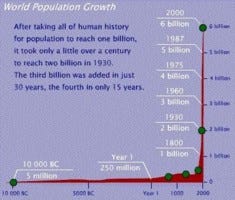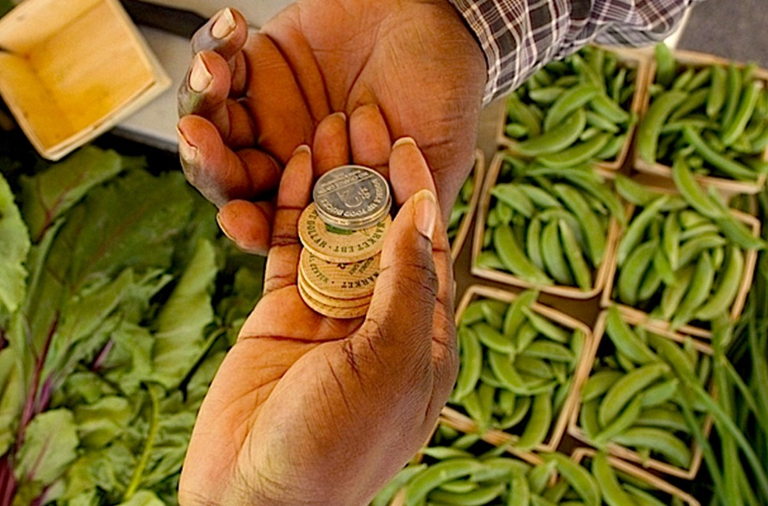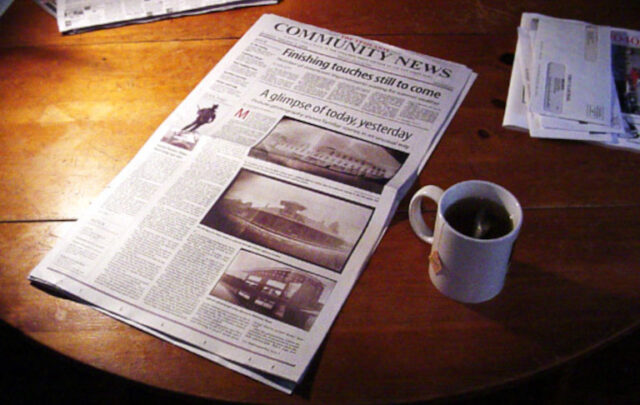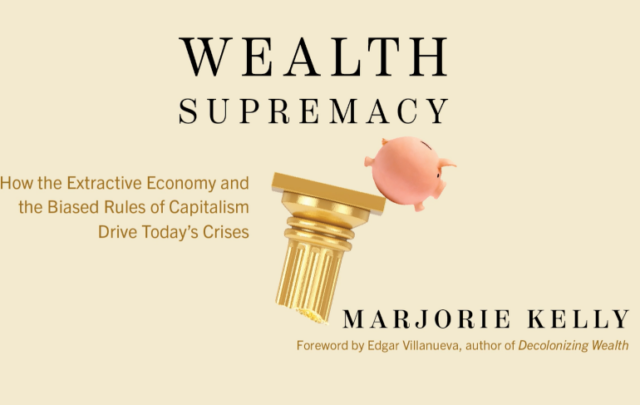This is an online course on living well within our means. The pun here is intentional. For, what we are exploring in this course is not just ways of reducing our consumption to levels that enable natural systems to self-regenerate, but that we do so in ways that permit a high quality of life — that we live within our means and that we live well.
A powerful story lies at the heart of our current economic system. It is a story of separation between humanity and nature. This story creates alienation, lack of belonging, fear and the need to control. Living this story ultimately makes us see through a lens of scarcity and competition for limited resources. Instead of living well within planetary boundaries and in collaborative abundance shared between all of humanity and life as a whole, we have chosen a path of trying to predict, control, manipulate and exploit nature as if we were somehow separate from life’s life-sustaining cycles that maintain this planet in habitable conditions for complex organisms like us.
The seeds of the story of separation between nature and culture — humanity’s attempts to live beyond natural limits go back as far as the oldest written document of our species. The Epic of Gilgamesh tells the story of downwind desertification and the collapse of the mighty empire of Babylon, because its ruler disregarded the warning of the forest god Humbaba and cut down the Cedars of Lebanon, even killed Humbaba. We — as a species — have had detrimental effects on ecosystems since before and certainly since the advent of agriculture, city-states and empires. The trend of understanding ourselves more and more as separate from or above the boundaries of nature’s life-sustaining processes has continued ever since.
 The Epic of Gilgamesh, the oldest written document of humanity warns us not to cut down forests
The Epic of Gilgamesh, the oldest written document of humanity warns us not to cut down forests
At the same time it is also true that most of humanity has evolved in locally and regionally adapted populations living in intimate reciprocity within the environmental challenges and opportunities of their region. Our species history shows that we are, as a species, capable of both devastating environmental destruction and of long-term careful co-evolution and stewardship of diverse and thriving ecosystems. Ultimately good economics is about meeting the needs of all of humanity in elegant partnership with the natural cycles that maintain the health and bio-productivity of diverse and thriving socio-ecological systems everywhere. When life thrives, we thrive.
Stories are powerful, they can affect how we perceive reality. If we design our economic systems on the basis of the story of separation, scarcity and competition, as we have done, we will live very differently than if we re-design economics based on a deep recognition of our interdependence with all of humanity and life. We can turn the zero-sum economics of someone winning resulting in someone else loosing into a non zero-sum economics where the individual, the collective and the planet benefit from win-win-win solutions. A collaborative economics of human solidarity informed by a participatory living systems view of life can generate shared abundance.
Charles Eisenstein, the author of Sacred Economics (2011), speaks of the cultural shift from the ‘story of separation’ to the ‘story of interbeing’ (2013). The story of interbeing acknowledges our mutual interdependence and interconnections and leads to a shift in worldview. It is this shift in worldview that underlies the emerging attempts at re-designing economics explored in this course.
Here is a short video (8min) of Charles Eisenstein talking about the story of interbeing. https://www.youtube.com/watch?v=Dx4vfXQ9WLo
Especially with the advent of the Scientific Era in the sixteenth century, humans have stood apart from the rest of nature, seeking to manipulate it for their benefit. This mechanistic approach of power over nature (prediction, manipulation and control) has given humanity enormous technological powers — many of them have saved lives and improved the lives of many, yet others have been put to a very destructive use. This technological development has accelerated with an increasing use of fossil fuels and the industrial revolution. Among other things these developments have caused an exponential increase in the world population over the last hundred years. There are ever more of us consuming non-renewable resources ever faster. It takes little genius to understand that these trends are unsustainable.

More on human population
Our dominant cultural story taught us to refer to the natural world as ‘the environment’ and to see it, in economic terms, as little more than a bank of resources to be transformed into products for human use and pleasure. This has brought us to the brink of collapse, with natural systems straining under the weight imposed by our numbers and the levels at which we are consuming.
We are, however, on the threshold of a fundamental shift in human affairs — into a new way of seeing and understanding the world and our place within it. The transition times we have entered mark a transformation even more significant than the agricultural revolution that enabled us to build empires and the Renaissance, the scientific revolution and the industrial revolution that enabled the development of our technological culture.
It was technology itself that enabled us to better understand our planetary life support system and develop alternatives to the current industrial growth society; and technology will play an important role in the transition towards life-sustaining societies and regenerative cultures. We need to blend the best of modern technological advances with the wisdom of living within planetary boundaries. We can create vibrant regional economies elegantly adapted to place, networked in national and international collaboration (see also module one of the Ecological Dimension).

Source: Gaia Education
The age we are moving into has been called the planetary era (Gillman, 2013; Kelly, 2010). Thomas Berry spoke of the transition into the Ecozoic Era “when humans live in a mutually enhancing relationship with the Earth and the Earth community.” It will be characterised by a new understanding of our place as a thread in the web of life, of our inter-connectedness with all of life.
Humanity in transition — From the Era of Empires to the Planetary Era

From Incontext Institute, Robert Gilman (Further Reading)
Economics has played at pivotal role in defining the nature of both the Era of Empires and the Scientific Era. It has shaped the currently dominant culture characterized by consumerism, unsustainable exploitation of the natural world and ever-widening wealth disparities within the human family. So it is here — in the way we understand and practice economics — perhaps more than in any other field that we need urgently to find new ways of thinking and being in the world.
The ‘story of separation between nature and culture’ and our structurally dysfunctional economic system based on inappropriate assumptions about human nature and resource scarcity are two of the most up-stream drivers of unsustainability. Richard Buckminster Fuller offers the challenge we face as we set out to create economic systems that serve people and planet:
“To make the world work for 100% of humanity in the shortest possible time through spontaneous cooperation without ecological offence or the disadvantage of anyone.” — R. Buckminster Fuller
We need a more holistic understanding of economics to inform a fundamental redesign of our economic and monetary systems at local, regional and global scales. We need to co-create a collaborative economics of human solidarity that is regenerative and operates safely within planetary boundaries. The new story underlying the re-design of our economic system has to recognize our fundamental interdependence in a reality where either all of humanity and life as a whole “wins” or in the long run nobody will win. As a general introduction to this dimension you may wish to watch one of the following videos:
The Economics of Happiness by Helena Norberg-Hodge (more) (68 min.)
Money and Life by Katie Teague (more) (86 min.)
The course begins (module one) by looking at how the global economy currently works; at the extent to which we are currently living beyond our means; and at how the global economy can be turned towards sustainability.
Specific attention is paid to the role of money (module two), and how it is currently created in the form of interest-bearing loans, in shaping the global economy as we know it today. We explore different possible ways in which money systems could be designed, including the creation by communities of complementary currencies, so that money can, once again, become our servant rather than our master.
Right Livelihood, examines values and the ethical dimensions to our economic life, exploring how the way we live, consume and invest can be brought into greater alignment with our values (module three). This module includes a re-examination of what constitutes true wealth, looking beyond financial capital to include social capital and natural capital.
Building Local economies (module four) looks at the various tools that have been developed on recent years to build and nourish local economies, including social enterprise, cooperatives and examples of ecovillage based businesses around the world.
Finally, we explore the legal and financial dimensions of creating organisations, social enterprises and other bodies to enrich our communities (module five). This includes how we can raise money to finance our projects and the legal forms that will be most conducive towards this end. We end with an exploration of some legal and policy changes that will help to accelerate the transition to a cooperative and regenerative economy for people and planet.
While this course frequently draws upon the experience of ecovillages in developing their own economies, it also refers to many other community-based initiatives from around the world that have developed tools and models that are of relevance to local economic revitalisation. The course will be of value to all those interested in the theory and practice of community economic development.
…
NOTE: this is an (edited) excerpt from the Economic Design Dimension of Gaia Education’s online course in Design for Sustainability. The first version of this dimension was written in 2008 by my friend Jonathan Dawson, now Head of Economics of Transition at Schumacher College. In 2015–2016, I revised the Design for Sustainability course substantially and rewrote this dimension with more up-to-date information and the research that I had done for my book Designing Regenerative Cultures.
The next installment of the Economic Design Dimension starts on March 19th, 2018 and runs for 8 weeks online. You can join the Design for Sustainability course at any point during the year.





